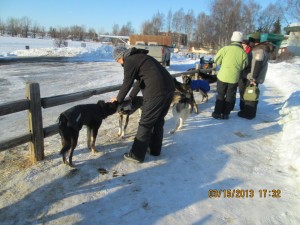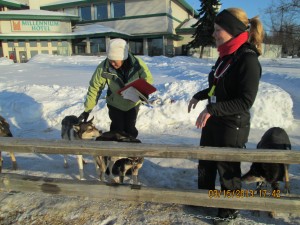7PM Anchorage—The Inside Story of the Dropped Dog

volunteers tether incoming dogs to a long gang line at the Milenium parking lot. Some dogs are immediately picked up, the remainder housed at Hiland Correctional Center

volunteers dissembles dog crates and egg crates them for return to airlines and used again for sled dog transport off the trail
I’m on my way home and took the afternoon flight from Nome to Anchorage. Before catching another flight I stopped by the Millenium Hotel which serves as the Iditarod headquarterters for logistics, communication, and a processing center for outgoing veterinarians, officials, volunteers, AND the hundreds of “dropped” air shipped off the Iditarod trail.
Invariably, some dogs in a team travelling 1000 miles are going to get injured or sick. Most mushers philosophically accept that all their chargers—the ones that they trained in the team all year– are not going to make the entire trail. Most mushers finish with nine to eleven dogs of their original 16 dog team. As you can imagine, a dog with a medical problems or an injury cannot keep pace with the team and the only logical plan is to leave a dog in a checkpoint, or in musher parlance “drop” a dog.
Truthfully, I have never seen what happens to the dropped dogs other than a general idea that they are gathered in checkpoints, and then sent to Anchorage, identified, reviewed by a team of veterinarians, and released to musher representatives. I was either racing or moving up the trail with a media group.
Looking out the Millenium café, I saw dogs being unloaded from a musher dog truck. Wow—I never realized that the dogs came here, and therefore walked out to take a few photos.
Dr. Pam May, DVM has been here for 10 days supervising the dog yard. “We have only 90 dogs here today, but it was crazy here when we had 160 dogs the other night.” Assisted by several other veterinarians and volunteers, each incoming dog was identified with a “chip reader,” and examined. Cross referencing with attached paperwork from vets on the trail is all part of the process. “We still have another plane coming in with additional dogs,” Dr. May said.
Dr. George Stroberg moved along one section of the long gangline. “We need more forms,” with a quick reply from a volunteer, “We’re working on it.”
Pam told me that she occasionally sends dogs to a veterinary clinic for specialized care. She had none designated in this group of dogs.
Musher representatives are called and informed that dogs have arrived in Anchorage. Many of the dogs are picked up immediately at the Millenium. The remaining dogs are loaded again into a dog truck and located at Hiland Mountain Correctional Center. Here they are cared for by inmates until mushers representatives show up to take them home. Dr May told me that she visits the dogs and is very impressed with the women, many of them 20 to 30 yeras old, who not only care for the basic needs of the dogs but give them some genuine love and attention. “Sometimes I find the women are with the dogs on their straw beds.”
Final Thought
The volunteers who stay camped here in Anchorage to take care of the dogs are true animal lovers. I saw moms and kids, young people, retired volunteers, and professionals like Dr. May giving their time. The empathy and dedication required to shepherd these sled dogs to their owners is extraordinary.



































